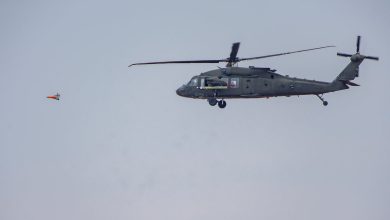Pentagon chief technologist argues case for rapid experimentation fund

Senate lawmakers last week proposed a fiscal 2025 defense funding bill that would siphon money from a Pentagon effort aimed at demonstrating capabilities that meet urgent needs across the combatant commands.
The Senate Appropriations Defense Subcommittee said in a report submitted with its bill that the program in question, the Rapid Defense Experimentation Reserve, or RDER, isn’t transitioning technology fast enough and lacks buy-in from the services.
Heidi Shyu, the Defense Department’s chief technology officer, told reporters Wednesday she thinks the subcommittee is missing the point. The military services aren’t RDER’s primary customers — rather, the combatant commands are.
And, she added, if the program is moving too slowly for some lawmakers, that’s largely due to funding delays and cuts that originated in Congress.
“With the money that we have, we had to stretch out things,” she said on the sidelines of the National Defense Industrial Association’s (NDIA) Emerging Technologies for Defense Conference and Exhibition. “I asked for a full cup of water, you gave me less than half. I have to sip it.”
The Pentagon established the program in 2021 when then-Vice Chairman of the Joint Chiefs of Staff Gen. John Hyten was concerned that the services overlooked COCOM needs. In response, the department created RDER to identify capability gaps that span multiple combatant commands and military services, find mature technologies it thinks can meet those gaps and then prove that they can through experimentation.
The program resides within the office of the under secretary of defense for research and engineering to ensure individual service priorities don’t override joint, COCOM requirements, Shyu noted.
“We created RDER to involve the joint staff and the COCOMs,” she said. “That’s the critical crux of RDER: To fulfill joint warfighting needs.”
The emphasis on jointness continues through the approval process. Once a capability demonstrates its viability, a panel of top military officials known as the Deputy’s Management Action Group — which includes combatant commanders, the joint chiefs and the undersecretaries of each military service — reviews the system and determines whether it should be funded and transitioned into production. The process is designed to take about two years.
Proving RDER’s value
Since RDER’s inception, Shyu and her team have been in an uphill battle to convince all four defense subcommittees that the program is meeting a unique need.
The department started the project selection process for the first round of RDER in 2022, garnering more than 200 ideas from the COCOMS, the services and defense industry. From that pool, it chose 32 capabilities. In its FY23 budget, the Pentagon requested $358 million for the selected proposals, but Congress cut funding to $272 million, requiring the department to whittle that list of projects to 23.
Due to extended budget deliberations, Shyu and her team didn’t have RDER funding in hand until March 2023, about five months into the fiscal year.
The Senate panel’s key complaint is that of those first 23 projects, about one-third have transitioned and most of those do not yet have a funding line in the services’ budgets.
“RDER to date has not resulted in accelerated fielding outcomes,” the subcommittee said in its report. “While the committee is supportive of data-driven joint experimentation, it is unaware of significant operational improvements derived from the RDER funding construct to date.”
Because of their concerns about RDER’s execution, the lawmakers recommend “slowing the rate of growth” the department has requested for the effort and shifting funding toward other DOD projects. The bill proposes creating a Rapid Defense Innovation Reserve that could be used for programs like Replicator — a Pentagon initiative to field thousands of attritable, uncrewed systems by August 2025.
The panel also calls for the department to review RDER’s progress and make a decision on whether funding should be diverted to other innovation efforts.
According to a spokesman for Shyu, the initial RDER numbers don’t tell the full story of the program’s momentum. It’s true that nine of the 23 first-round projects have transitioned and only five of those have dedicated funding, but the two-year process doesn’t conclude until next year, the spokesman told Defense News. In that time, another 11 projects from the first phase will be presented to senior leaders for approval.
The department has selected another 51 projects for the second phase of RDER, 25 of which were funded for experimentation.
Shyu acknowledged some of the first-round projects weren’t ready after the initial demonstrations and needed to go back through the cycle, but said that possibility is built into the two-year process.
Most of the nine projects that have transitioned are classified, but Shyu said several are already proving to have military utility. One effort, the Family of Integrated Targeting Cells, is being procured by the U.S. Marine Corps to integrate multiple sensors into a common operating sensor. By pushing the capability through RDER, the service was able to shave five years from its acquisition schedule.
In a speech at the NDIA conference Wednesday, Deputy Secretary of Defense Kathleen Hicks said RDER plays a key role in helping the department determine which capabilities are ready to be produced and fielded and which aren’t.
Communicating the importance of efforts like RDER and Replicator to Congress has been a challenge, Hicks said. To get lawmakers on board with Replicator, for example, the Pentagon has held nearly 40 meetings with lawmakers and their staffs since last October.
That level of engagement isn’t possible for all of the Pentagon’s innovation efforts, she said.
“We need just as much help from Congress in ensuring joint experimentation can enable delivery of effective capabilities to the warfighter,” Hicks said. “From Replicator’s success to combatant command priorities like the Joint Fires Network, we need efforts like RDER that bring rigor to our discernment of what is and isn’t ready to scale.”
Courtney Albon is C4ISRNET’s space and emerging technology reporter. She has covered the U.S. military since 2012, with a focus on the Air Force and Space Force. She has reported on some of the Defense Department’s most significant acquisition, budget and policy challenges.







